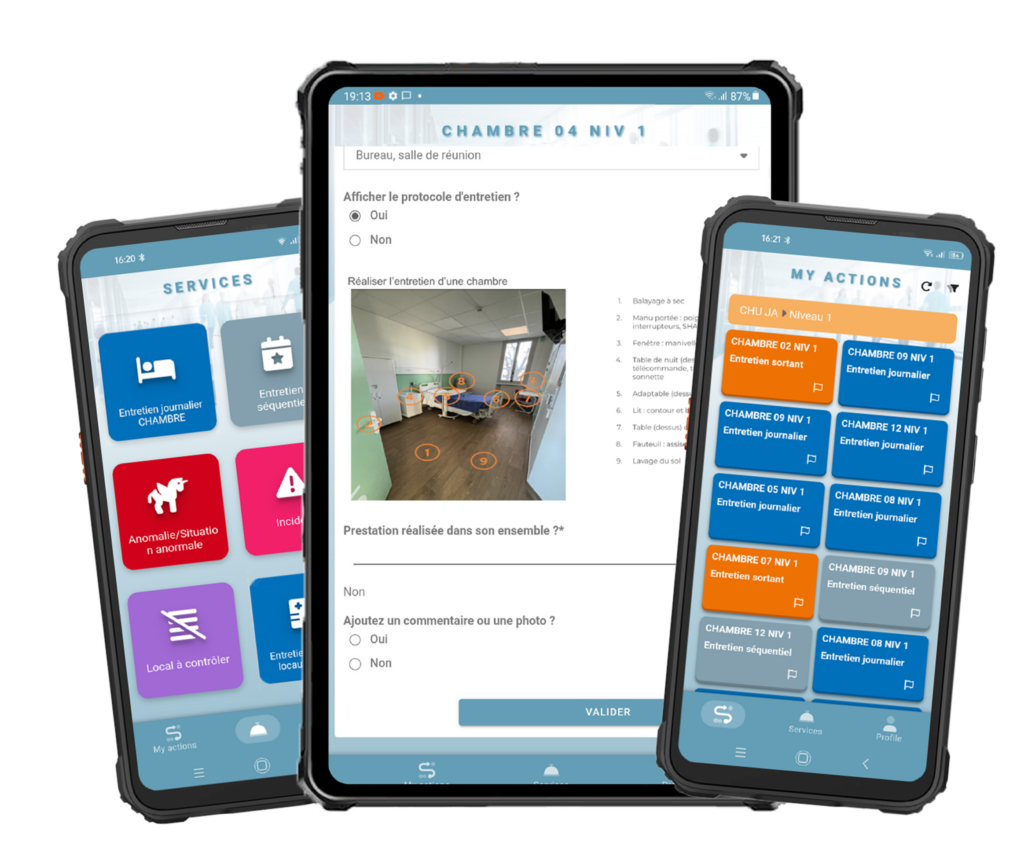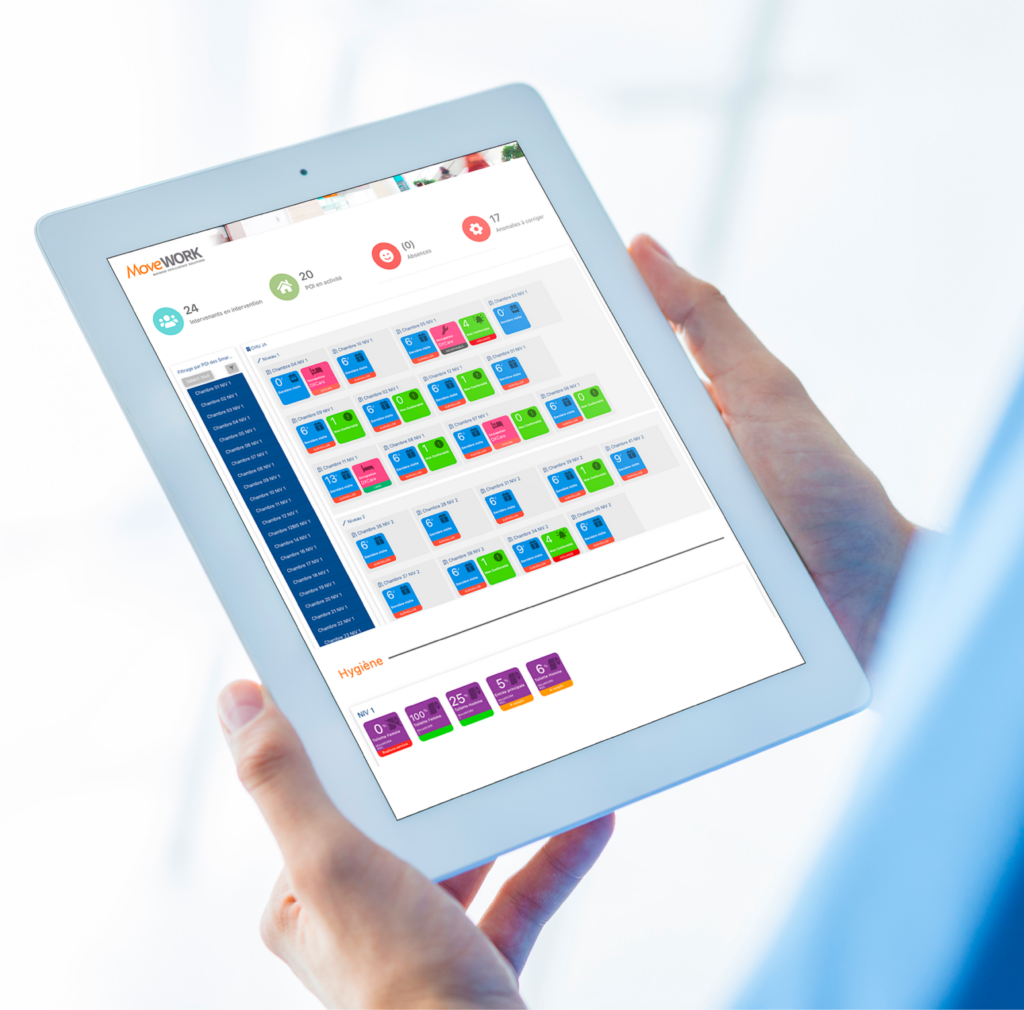Who took care of the sequential cleaning of patient room 364? Which support staff members were present for the night rounds? Where is the protocol for cleaning high-risk areas? A hospital department is like a bustling hive! Between administrative tasks, operational monitoring, and strategic management, navigating it all is no small feat. To optimize the coordination of your hospital department, various methods and tools are available. MoveWORK provides an overview!

The risks of poorly coordinated hospital departments
Hospital departments are full-fledged organizations. Like any entity, they operate under a specific hierarchy and regulations. It’s a complex environment where multiple data flows, workflows, and resources interact and intertwine. Therefore, seamless information transfer between healthcare services and stakeholders is crucial to ensure patient safety and the well-being of hospital staff.
Effective coordination minimizes the risks of medical errors, contamination or hospital-acquired infections. Indeed, inadequate communication and visibility regarding interventions often lead to critical incidents with significant human and legal consequences.
the consequences of a lack of coordination
Poorly managed hospital department can negatively impact a large number of stakeholders. The ripple effects of incidents are unpredictable and can affect your patient base, employees, and overall structure:
- Medical errors: Disorganization can have catastrophic health impacts, and in some cases, fatal consequences. Whether it’s incorrect administration of treatment, oversight in cleaning protocols, or inadequate supply replenishment, all these shortcomings jeopardize your hospital environment.
- Redundancies and resource wastage: A disorganized hospital department lead to unnecessary task duplication. These time-consuming actions overburden staff and contribute to burnout. In addition to staff pressure, this disorder causes inefficient resource allocation and cumbersome use of medical equipment.
- Decline in quality of care: Employee burnout combined with healthcare shortcomings inevitably lead to deteriorating patient care. Dissatisfied patients and a declining reputation for your healthcare facility are the result. Furthermore, teams struggle to adhere to protocols and standards due to resource shortages, resulting in increased complaints and litigation.
- Disengagement of hospital teams: Increased stress due to service confusion and disorganization significantly reduces staff motivation. Maintaining a positive and productive work environment becomes challenging.
- Poor management of emergency situations: A disorganized hospital department lacks responsiveness. Who does what? Where are the equipment and procedures? What has already been done in this patient’s room? Without traceability of information, effective responses to critical situations are hindered.
- Negative financial impact: These errors, oversights, and redundancies inevitably lead to financial losses. From poor stock management to decreased satisfaction and costs associated with claims, your healthcare facility faces substantial financial burdens.
Manual management: the number one factor of disorganization
Whether it’s a hospital, a medical-social structure, or a clinic, a large majority of healthcare facilities still rely on paper to manage their operations. From note sheets to sticky notes to whiteboards, regardless of the manual method used, the transfer of data and information occurs in a chaotic and disorganized manner.
Managing and tracking interventions on paper is the primary cause of errors in a hospital service. On one hand, this method offers no traceability of events or visibility into the service’s current situation at any given moment. On the other hand, aside from potential losses or oversights, paper-based management provides no guarantee of the reliability of the collected data. Coupled with information arriving via phone calls, paper management is both detrimental and adds pressure to the teams.

Diagnosis and audit of hospital service
To optimize the coordination of a hospital department, the first step is to analyze existing coordination issues. What methodologies are currently in place? Is there already a methodology established? What are the roles of each stakeholder in the operational management of the service? All these elements must be identified, listed, documented, and scrutinized to pinpoint the origins of dysfunction.
The complexity of internal processes, often fragmented and decentralized, can hinder operational fluidity. Additionally, interdepartmental communication may be insufficient and impede the transmission of information between medical teams and support teams.
Here is a non-exhaustive list of points to verify:
- Communication channels used and their effectiveness
- Digital tools and software deployed, their complexity level, and precision
- Management processes for attendance, scheduling, rounds, and replacements
- Distribution of staff across intervention zones: healthcare providers, service agents, contractors, etc.
- Workflow management method
- Allocation of material resources and operational equipment
- Definition and availability of protocols
- System for monitoring compliance with procedures and regulations
- Traceability system for requests, incidents, and anomalies
- Continuous staff training plan
- Evaluation procedures for interventions and adjustment methods
- Collection of patient feedback and implementation of satisfaction improvement strategies
Depending on your healthcare facility and the specialty of the audited hospital service, this list may vary in complexity. However, if any of these parameters are deficient or absent, the risks of disorganization are very high.
Digitization of operational processes
To optimize the management and control of workflow in a hospital service, the next step is to digitize operational processes. Digitalizing data exchanges, task allocation, or quality control offers significant advantages: collective and individual performance, consistency of information, improved resource distribution, enhanced health safety, better quality of care, and cost reduction….

Now that you’re convinced of the benefits of digitization, it’s time to take action! To digitalize the management of your hospital department, several tools can be implemented:
- Task automation tools: Say goodbye to time-consuming, repetitive, and stressful tasks. With these devices, everything is collected and processed automatically. This includes retrieving work hours, tallying discharged patient rooms, transcribing quality controls… All these actions are digitized to reduce errors and accelerate processes.
- Scheduling and attendance management systems: Between hospitalization teams, consultation teams, and substitutes, it’s not always easy to keep track. These tools facilitate the organization of hospital teams and enable efficient scheduling, optimizing routes and emergency responses.
- Collaborative platforms: These secure interfaces are ideal for aligning the operational vision across all hospital department. Everyone knows exactly what interventions are ongoing, upcoming actions, and available teams. These tools offer customizable functions for reporting and information exchange.
- Instant request systems or incident reporting: These devices simplify the management of emergencies and unforeseen events. Customizable service kiosks allow field-detected situations to be easily escalated to the hospital department head or the appropriate contact person. Whether through a mobile application or an online interface, the instantaneous transfer of information ensures continuous service quality.
- Inventory management software: These specialized tools for the healthcare sector enable anticipation of equipment or consumables orders. They provide real-time monitoring of stock levels and alert the purchasing department when critical thresholds are reached.
By leveraging these digitalization methods, hospitals can not only enhance the efficiency of their daily operations but also strengthen the quality of patient care.
Discover how MoveWORK digitized the traceability of cleaning procedures at the University Hospital of Montpellier
Digitization of quality monitoring in the hospital service
Once operational processes are digitized, it’s time to focus on quality management! Monitoring, tracking, and mastering quality indicators are the top priorities in hospital departments. As mentioned earlier, manual management has its limitations. Therefore, equipping oneself with high-performance digital tools appears to be the best initiative:
- Mobile applications for quality control
- Monitoring and reporting tools
- Interactive dashboards
- Connected devices for remote monitoring of indicators
- Satisfaction survey systems and continuous evaluation
- Quality management platform and automation of corrective actions
All these tools offer essential functionalities to ensure protocol adherence in hospital services. They enable real-time monitoring of hospital performance and provide an overview of key quality indicators: compliance rates, response times, types and frequencies of anomalies, and more. Moreover, these analytical solutions facilitate identifying bottlenecks and allow for quick adjustment of intervention paths when necessary.
Digitizing a hospital department : an learning challenge
Attention, all these digital devices will have no effect if they are not fully adopted by your hospital staff. Indeed, changing habits is not always easy! That’s why a comprehensive support plan must be designed and implemented to ensure high adoption rates among hospital teams.
To achieve this, training programs on the new digital tools are crucial. These learning sessions will familiarize staff with the technologies and maximize their usage. Regular coordination meetings, such as briefings and debriefings, are essential in a digitized hospital environment. They allow teams to discuss priorities, challenges, and outcomes.
Strong leadership is therefore essential to guide the digital transition, actively integrating innovation into daily practices.
MoveWORK Flow : the all-in-one platform to manage a hospital department
Operations, quality, presence… What if you could combine all these functionalities into one tool? With its comprehensive 360° management interface, the MoveWORK Flow platform is specially designed to optimize hospital service management.
On one hand, its intelligent task automation algorithms significantly reduce the workload for hospital teams. By automating data collection and processing, the solution saves days of work. For example,

MoveWORK Flow can automatically retrieve and analyze staff attendance data, optimize schedules based on forecasted needs, and generate detailed reports without direct human intervention.
MoveWORK Flow is also capable of interpreting real-time situations. By combining various sources of information such as consumables usage records, service requests, or quality control results, the platform automatically identifies anomalies and triggers appropriate actions. This proactive approach enhances the responsiveness and operational efficiency of the hospital service.
Finally, to ensure the success of your projects, MoveWORK offers comprehensive support for institutions committed to digitizing their processes. With dedicated coaching, technical consultants, and training plans, everything is implemented to meet your objectives.

